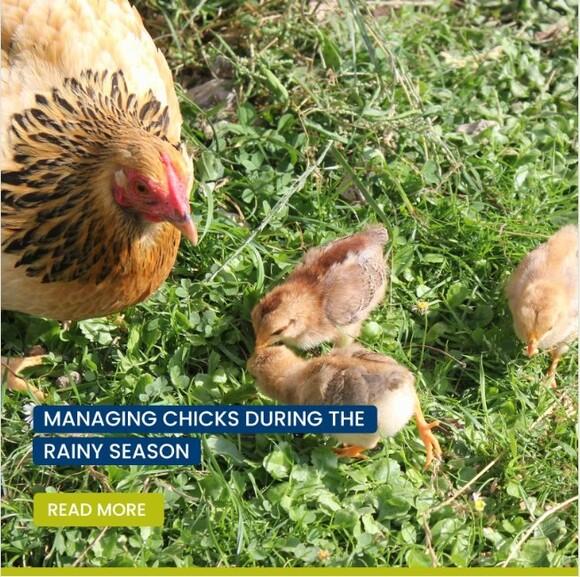Explore all the information on
Baby chicks management
When chicks arrive at the housing facility, it is important to ensure that the barn is set up for proper brooding. Chicks will transition from a very tightly controlled and conditioned life at the hatchery to a more independent life at the broiler farm. This means ensuring proper temperature/humidity, excellent water quality and ventilation, and ensuring easy access to feed. With such a short growing period, chick health in the 7 days after placement can really set the stage for performance over the entire grow out period. Another important component for neonatal health and disease control is ensuring, cleaning, disinfection and down time between groups and excellent biosecurity practices when chicks are in the barn. Due to advances in poultry genetics, knowledge of nutrition, bird management and disease control, broilers grow very fast. Their growth rate is dependent on the amount of energy (calories) in their feed. A 3-feed program is most efficient and cost effective program.
INTRODUCTION Agric Trade business in Day Old Chicks( DOC) and value chain products is still poorly developed in the West Africa sub region, and must be strengthened in order to contribute and impact on the intra regional agricultural business and trade movement in other to increase poultry food security in the region in line with the presidents Global Food security Response (GFSR). ...
Comments : 40
Recommendations: 2
Henk Struving, Sales Director at Heering, introduces advanced transport solutions for day-old chicks developed by this Dutch family-owned company. With global experience and partnerships with genetic companies like Hi-Lyne, Heering ensures safe and efficient transportation from hatcheries to farms. ...
Comments : 0
Recommendations: 0
Sudipto Haldar (Research Director at Agrivet) talks about eubiosis, dysbiosis and digestibility, as well as the role of enzymes, probiotics and phytogenics, in this Engormix interview....
Comments : 0
Recommendations: 2
I. BACKGROUND The scale of the Australian chicken-meat industry has increased at an extraordinarily rapid rate so that now chicken-meat is clearly the first preference of consumers in comparison to pork, beef and lamb. In 1990/91, the Australian population was 17.2 million with a per capita chicken-meat consumption of 23.9 kg; however, this increased by 61.0% to 27.7 million people and consumption increased by 100% to 47.8 kg over the 30 years to 2020/21. As a direct consequence, the...
Comments : 0
Recommendations: 0
Mueez Ahmad (Arm & Hammer) Enterococcus faecalis is considered a normal inhabitant of the poultry gastrointestinal tract. Although it has been known to be an opportunistic poultry pathogen, high levels of this organism can be recovered from the intestinal tract of normal, healthy birds with no known disease issues. More recently, an increasing number of poultry veterinarians and diagnostic laboratories have been reporting that E. faecalis is...
Comments : 0
Recommendations: 0
Mueez Ahmad (Arm & Hammer) gives a presentation on Enterococcus faecalis and Escherichia coli and their impact on decreased hatchability, during the 11th Symposium on Gut Health in Production of Food Animals in St. Louis, USA....
Comments : 0
Recommendations: 0
Proper chick management is crucial for optimal performance during the rainy season. Challenges like humidity and damp conditions can impact their health and growth.
Maintaining a clean, dry environment is essential to minimize mold and bacterial growth. Adequate shelter, ventilation, and high-quality feed are vital for chick well-being....
Comments : 0
Recommendations: 0
Brooding can simply defined as “Application of heat to the birds at early part of their life”. Brooding is the care of young chicks by provision of optimum environment. The temperature by external heat source provided until the chicks not become able to regulate its body temperature efficiently. The temperature is most important...
Comments : 7
Recommendations: 0
.jpg&w=3840&q=75)

Effects of dietary sulfur amino acid levels in broilers challenged with Eimeria spp
Suggested link
INTRODUCTION Chicken meat consumption has drastically increased in the past decades, and Australia has the fourth highest consumption of chicken meat in the world, eating 47.64 kg/person in 2020 (ACMF, 2021). The success of the poultry industry is highly related to the improved growth and performance capabilities of chicken meat birds with some strains of broilers capable of reaching market weight by 35 d of age (Singh et al., 2021). The industry now requires new approaches to...
Comments : 0
Recommendations: 3
Pathogen control is a crucial challenge faced especially in the young animal stage of production. Young animals are very prone to pathogen infection since their gut takes time to fully develop. In this TechTalk, Annafe Perino, Product Manager from Southeast Asia and Pacific, shares how organic acids work to support animals in managing gut pH, fighting pathogenic bacteria as well as controlling pathogen proliferation....
Comments : 3
Recommendations: 3
The parents of broilers are defined as broiler breeders. In contemporary poultry industry practices, there are many selection criteria for broiler breeders. Beyond selecting for future broilers, maximizing broiler breeder characteristics (i.e. reproductive success) is also important. In essence, we are not only selecting for...
Comments : 1
Recommendations: 1
It is very important to have good uniformity in broilers to maximize the performance. Variation in their body weights causes lot of complications and problems. If the flock is not uniform, it will take longer time to grow and many rejections at slaughter house. Different type of enteric and other diseases can easily disturb the flock resulting in severe economic losses. FCR is badly affected by unevenness in a flock and the result is less profitability. If the...
Comments : 5
Recommendations: 3
.jpg&w=3840&q=75)

Travis Schaal talks about the importance of biosecurity to prevent avian influenza outbreaks
Suggested link
The on-going battle against African Swine Fever and Covid-19 have caused major challenges globally affecting both food production and food security. This has been very evident in swine production, as most top pork producers and exporters were affected. Spain, being the top pork exporter, was among the first countries to be hit by the Covid-19 pandemic causing disruptions in pork supply not only to its exports but also affecting domestic supply in EU as well. This has also significantly...
Comments : 0
Recommendations: 1
Digestive capability of young animals is different when compared to adult growing pigs and chickens. In this TechTalk, Ermin Magtagnob, Novus Technical Services Manager from Southeast Asia and Pacific, discusses how protease enzymes can assist in managing gut health problems associated with undigested proteins....
Comments : 0
Recommendations: 0
Copper is very useful for young animals’ gut health, particularly for the integrity of the small intestine. In this final Young Animal TechTalk, Matthew Bekker, Technical Services Manager for Novus Southeast Asia and Pacific, shares how copper in chelated form is highly valuable to chick’s and piglet’s epithelial cells and villous structure....
Comments : 0
Recommendations: 4
Early nutrition and feeding play a very important role to modulate the immature immune system of chicks and piglets. In this TechTalk, Teera Tiyasatkulkovit, Technical Services Manager for Novus Southeast Asia and Pacific, talks about how essential oils can complement the animal’s innate immune system and enhance their adaptive immune system to protect young animals and support their growth....
Comments : 0
Recommendations: 2


Overview of Performance of Listed Vitamin Companies in 2023
Suggested link
Each year many people enjoy ordering chicks from a hatchery or purchasing young chicks from a feed store. These chicks are raised primarily for home laying flocks. Some of these chickens are raised for the family table, while others are kept mainly as pets. Whatever purpose the adult chickens serve, special care must be given to young chicks in order for them to survive and grow into healthy adults. Care of Chicks Chicks, or...
Comments : 2
Recommendations: 1
Shawna Weimer (University of Maryland) discusses one of the latest impacts COVID-19 has had on the poultry industry: Mail Order Chicks. Let's Squawk About It is a monthly interview segment by the Poultry Science Association....
Comments : 3
Recommendations: 0


An impact of Deoxynivalenol produced by Fusarium graminearum on broiler chickens
Suggested link
INTRODUCTION Broiler hatching eggs can be stored at temperatures lower than ambient temperature before incubation, which is a common practice in commercial breeding farms and hatcheries. As per the variable market demand for 1-day-old parent stock chicks and the hatchery capacity, the duration of egg storage varies. Normally, commercial hatcheries set their eggs after 3 to 5 d of storage to minimize the negative effects of...
Comments : 0
Recommendations: 0
Early feeding can improve broiler performance and welfare The first experiences of a day-old chick play an important role for the development and performance of chicks later in life. Especially for broilers, one or two days make up a large portion of their relatively short...
Comments : 0
Recommendations: 3







.jpg&w=3840&q=75)












.jpg&w=3840&q=75)











